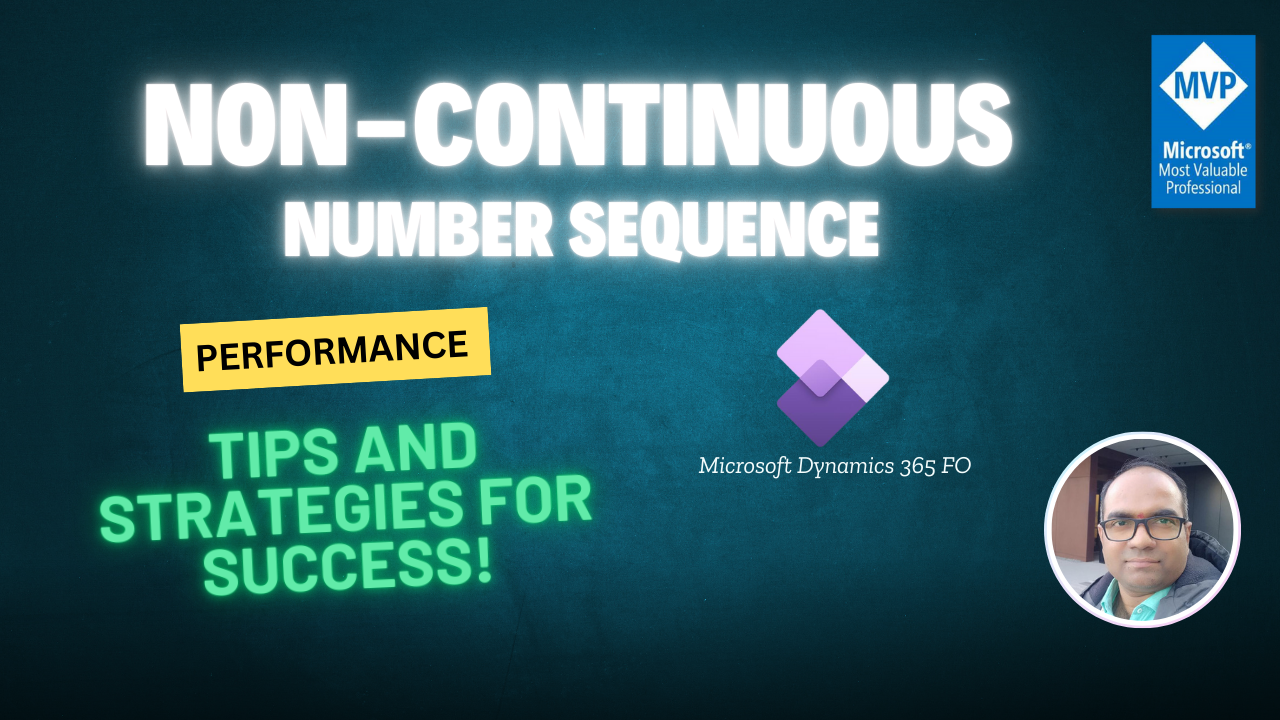Improve Dynamics 365 FO Non-continuous Number sequence Performance: Tips and Strategies for Success!
 Rakesh Darge
Rakesh Darge
Navigating performance issues in Dynamics 365 FO can be quite a challenge. There are numerous factors and considerations to take into account to ensure optimal performance in a production environment. It’s a puzzle that requires careful attention and strategy to solve!
While diving into the performance issues of our Dynamics 365 FO production system, I always make it a priority to examine the number sequences. Whether they’re standard or custom, this crucial step in the configuration process can make all the difference.
It's amazing how such a small detail can have a significant impact on overall performance!
What are the different types of number sequences?
As you may be aware, Dynamics 365 FO offers an exciting feature with its two types of number sequences! These allow for greater flexibility and control in managing your data. Let’s dive into how these can enhance your experience!
Continuous
Non-Continuous
I won’t dive into the specifics, as each and every consultant from Dynamics 365 ERP is already well aware of the situation. Instead, let's focus on how we can move forward together!
For anyone just embarking on their journey in Dynamics 365 Finance and Operations, it's essential to familiarize yourself with number sequences! Continuous number sequences are crucial in scenarios where legal regulations require a seamless, gapless flow of transaction numbering. On the other hand, non-continuous number sequences offer the flexibility of having gaps. Understanding these concepts will provide a solid foundation for your career in this dynamic field!
In this blog post, I’m excited to share some valuable tips and tricks that I’ve learned along the way for correctly defining FetchAheadQty when dealing with non-continuous number sequences.

Before we dive into the details, let's explore the various business scenarios where this can truly make an impact!
A common business scenario:
Think about evaluating the average number of lines for transactions that utilize the number sequence.
What Should and Should Not Be Enabled?
Enabling non-continuous numbers can be a great feature, but if you skip pre-allocation, you might run into some real challenges.
Firstly, you’ll face an increased number of database lookups, which can slow things down.
Secondly, you could encounter potential contentions on the NumberSequenceTable, complicating operations.
Lastly, by not leveraging the caching capabilities available on AOS, you’re missing out on a performance boost.
Make sure to consider these aspects to keep your system running smoothly!
Throughout my performance reviews, I've often noticed that the numbers specified in the Preallocation section of the Performance FastTab on the Number Sequences page don't quite hit the mark. It's a common theme that these values can be misdefined or just not suitable for our needs.

Let’s explore ways to address this issue!
Here are the suggestions/recommendations
| Quantity of numbers | Avg. number of transactions | Frequency |
| ~100 | 75000+ | Each Day |
| ~20-50 | 25000+ | Each Day |
| ~10 | 10000+ | Each Day |
Note : When the number sequence is set to non-continuous but the fetch ahead quantity isn’t specified, it leads to the creation of a separate database for each number sequence that’s retrieved. This can result in a fragmented approach that may impact efficiency. Let’s ensure we’re setting everything up correctly for seamless data management and production workloads.
Conclusion
Using Preallocation can significantly enhance performance. As you embark on your next implementation project, embrace these steps to elevate the performance of non-continuous number sequences!
Hope you found this post helpful!
Happy performance issue triage!
Thank you for Reading - Let's Connect!
Thank you for reading this piece. If you enjoyed it, please let others know. Hit the subscribe button to read more posts from this blog. LinkedIn, Twitter, YouTube
Stay tuned!
Subscribe to my newsletter
Read articles from Rakesh Darge directly inside your inbox. Subscribe to the newsletter, and don't miss out.
Written by

Rakesh Darge
Rakesh Darge
This blog is my contribution to the Dynamics 365 Finance & Supply chain management & Power Platform community. Having worked with Axapta / Dynamics AX / D365 F&O for 18 years out of my 21 years of career in application development and ERP. I'm passionate about Dynamics 365 ERP, Power Platform & Azure integrations 💡. However, I tend to always look forward. So I mostly write about current subjects. My aim is that my deep thought may inspire some of you and provoke some new thoughts in the interest of our community. Please note, that the views expressed in this blog are mine alone and do not necessarily reflect the view of my employer.